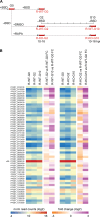The Plasmodium falciparum histone methyltransferase PfSET10 is dispensable for the regulation of antigenic variation and gene expression in blood-stage parasites
- PMID: 39445826
- PMCID: PMC11580404
- DOI: 10.1128/msphere.00546-24
The Plasmodium falciparum histone methyltransferase PfSET10 is dispensable for the regulation of antigenic variation and gene expression in blood-stage parasites
Abstract
The malaria parasite Plasmodium falciparum employs antigenic variation of the virulence factor P. falciparum erythrocyte membrane protein 1 (PfEMP1) to escape adaptive immune responses during blood infection. Antigenic variation of PfEMP1 occurs through epigenetic switches in the mutually exclusive expression of individual members of the multi-copy var gene family. var genes are located in perinuclear clusters of transcriptionally inactive heterochromatin. Singular var gene activation is linked to locus repositioning into a dedicated zone at the nuclear periphery and deposition of histone 3 lysine 4 di-/trimethylation (H3K4me2/3) and H3K9 acetylation marks in the promoter region. While previous work identified the putative H3K4-specific methyltransferase PfSET10 as an essential enzyme and positive regulator of var gene expression, a recent study reported conflicting data. Here, we used iterative genome editing to engineer a conditional PfSET10 knockout line tailored to study the function of PfSET10 in var gene regulation. We demonstrate that PfSET10 is not required for mutually exclusive var gene expression and switching. We also show that PfSET10 is dispensable not only for asexual parasite proliferation but also for sexual conversion and gametocyte differentiation. Furthermore, comparative RNA-seq experiments revealed that PfSET10 plays no obvious role in regulating gene expression during asexual parasite development and gametocytogenesis. Interestingly, however, PfSET10 shows different subnuclear localization patterns in asexual and sexual stage parasites and female-specific expression in mature gametocytes. In summary, our work confirms in detail that PfSET10 is not involved in regulating var gene expression and is not required for blood-stage parasite viability, indicating PfSET10 may be important for life cycle progression in the mosquito vector or during liver stage development.IMPORTANCEThe malaria parasite Plasmodium falciparum infects hundreds of millions of people every year. To survive and proliferate in the human bloodstream, the parasites need to escape recognition by the host's immune system. To achieve this, P. falciparum can change the expression of surface antigens via a process called antigenic variation. This fascinating survival strategy is based on infrequent switches in the expression of single members of the var multigene family. Previous research reported conflicting results on the role of the epigenetic regulator PfSET10 in controlling mutually exclusive var gene expression and switching. Here, we unequivocally demonstrate that PfSET10 is neither required for antigenic variation nor the expression of any other proteins during blood-stage infection. This information is critical in directing our attention toward exploring alternative molecular mechanisms underlying the control of antigenic variation and investigating the function of PfSET10 in other life cycle stages.
Keywords: CRISPR-Cas9; PfEMP1; PfSET10; Plasmodium falciparum; RNA-seq; antigenic variation; gametocytes; histone methyltransferase; malaria; var genes.
Conflict of interest statement
The authors declare no conflict of interest.
Figures





References
-
- World Health Organisation . 2023. World malaria report 2023. Geneva: WHO Press
MeSH terms
Substances
Grants and funding
LinkOut - more resources
Full Text Sources
Research Materials
